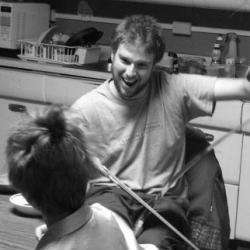On Friday night, the Irish new music group Crash Ensemble produced some sonic pyrotechnics to match the Scriabinian lights display at Carnegie Hall’s recently renovated Zankel Hall. Besides moving your reviewer to adjectives of dubious origin, Zankel managed to entertain and soothe the audience with soft reds and cool blue-greens during breaks and intermissions without distracting any attention from the music or musicians. Despite a range of works by the popular and vigorous composers Osvaldo Golijov and Donnacha Dennehy, the 6pm crowd only filled about two-thirds of the hall’s seats.
Beginning with Golijov’s oft-performed Lúa Descolorida (“Colorless Moon”), a setting of a 19th-century poem by Rosalía de Castro, Dawn Upshaw and Crash’s string quartet continued without interruption into How Slow the Wind, a setting of two Emily Dickinson poems by the same composer. In both pieces, Upshaw’s fine-tuned expressive control often benefited from Golijov’s subtle and intimate string writing, which often consisted of a differing intensity of vibrato across the individual members of the quartet. Lúa’s lugubrious melodies remained in excellent hands as Upshaw drew every bit of affective feeling from them without ever seeming melodramatic. Her voice, it seemed, was actually capable of reaching out and pulling every hair on your neck up straight. I felt the frisson of her most poignant moments even as she and the quartet returned to the stage for their curtain call.
The first half of the program ended with the first piece by Donnacha Dennehy, the 1997 founder of Crash Ensemble. Grá agus Bás (“Love and Death”, 2007) consisted of the huge, soaking wet reverberation of vocalist Iarla Ó Lionáird alternating with the sounds of the modified chamber orchestra, which included electronics and electric guitar, among the more traditional trombone, strings, and clarinet. The instrumentation was largely skilful; the electric guitar’s distorted, floating pads of color, tastefully and sparely used, were particularly reminiscent of Arvo Pärt’s prepared piano in his orchestral Tabula Rasa. The bass clarinet also played a visible but small role in the tutti sections, and led me to ponder the ubiquity of this instrument in a certain brand of new music composition.
The first theme area of the piece was about as expected: a lush and heavily doubled garden of sound. But the second theme group lacked teeth, with a fast compound meter (perhaps a faint allusion to a jig or reel) and four-string full-bow action in the strings. The dramatic bowing action was not different enough for the timbral and metric gesture to come off correctly. Nevertheless, the second statement of the theme made more sense, as it approached the quasi-jig texture gradually rather than abruptly.
The final piece on the program, Dennehy’s That the Night Come, was a setting of W.B. Yeats’ poetry. Unfortunately for the high ambitions of the cycle of songs, Yeats’ words did not suit the musical treatment they received. The greatest books emphatically do not make the greatest films, and neither do such poems make such songs. A particularly grinding moment came in the fifth movement, when an utterly predictable stringed lament accompanied Yeats’ words “All true love must die”. Ultimately, the problem for the music seemed to be that there weren’t enough words, and the words that were there did not yield easily their subtlety and meanings. Thus we were left with empty, mechanical repetition of words either hopelessly opaque or wincingly maudlin.
The personal relationship between performer and composer seemed to permeate every aspect of Friday’s program. It is a recurring theme with Golijov (at the University of Chicago several years ago, he made specific reference to the laptop artist as well as Ms Upshaw in his writing process for the song cycle Ayre), and Grá agus Bás, too, was the product of Dennehy working specifically with the sean nós style of Ó Lionáird. Aisling Gheal, liberally arranged for cello and electronics, addressed the conceit of “working with” or “working through” by its status as a loose interpretation of a traditional folk tune – in fact, the folk tune most heavily used in the construction of Grá agus Bás.
Even accounting for that thread running through the sequence of works, there was still another centerpiece of the program – Dawn Upshaw herself. As a less-than-subtle focus of the evening’s music-making, Ms Upshaw was featured on three of the program’s five pieces, and two of those works were written expressly for her, one by each of the composers. Without her explosive and evocative presence, the music could never have reached the heights it did.


